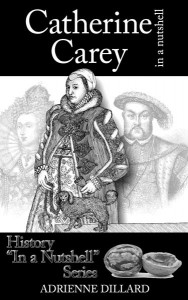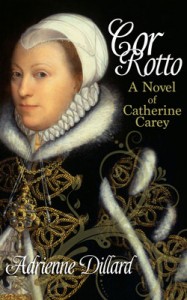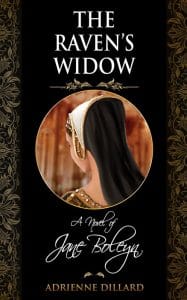 On this day in history, 26th April 1540, Catherine Carey, daughter of Mary Boleyn and niece of the late Queen Anne Boleyn, married Francis Knollys.
On this day in history, 26th April 1540, Catherine Carey, daughter of Mary Boleyn and niece of the late Queen Anne Boleyn, married Francis Knollys.
Thank you to Adrienne Dillard, author of two books on Catherine Carey – the novel Cor Rotto and the non-fiction book Catherine Carey in a Nutshell – as well as a wonderful novel on Jane Boleyn, The Raven’s Widow, for sharing this extract from her non-fiction book.
In Tudor England, more often than not, marriage in the nobility and upper classes was the result of very careful dynastic planning on the part of two families looking to consolidate their interests. It also seems to have been very rare for a courtship to have organically grown between two people out of their own volition. Two people could form affectionate bonds before marriage, but those bonds usually came about because they were already promised to each other or there was an expectation that they would be. It wasn’t impossible for two people to fall in love and get married, but it was definitely the exception and not the rule. Sometimes there wasn’t even time for a courtship. Marriages could be arranged and consummated in a matter of weeks. Fortunately, there was always a chance that the two strangers who found themselves at the altar would grow to deeply love and respect each other as if they were soulmates. It is unknown whether the marriage between Francis Knollys and Catherine Carey was the result of a love match or a very lucky arrangement, and the primary documents don’t reveal many clues.
While there is no clear evidence of Catherine’s whereabouts from her birth to around age fifteen, it is documented that Francis sat for parliament before he was appointed to the king’s bodyguard in 1539 and, though there is no official record of it, tradition says that he attended Magdalen College, so it is likely that he was around his childhood home of Rotherfield Greys in Oxfordshire for most of his youth. It seems then that the two might have met in November 1539. Both appear in the Letters and Papers of Henry VIII. Francis is listed as one of the men sent to greet the king’s fourth wife, Anne of Cleves, upon her arrival at Calais and Catherine is listed as one of the maidens ready to meet Anne once she arrived at court. There aren’t any obvious links between the two families, but Catherine’s stepfather, William Stafford, is listed in the same welcoming group as Francis. The papers show that Catherine was listed in the group set to meet the queen at Dover, so it is unlikely that they travelled over together if Catherine was living in Calais at the time. She either came over earlier than Francis and her parents or she was already living somewhere in England with her mother. Perhaps William Stafford was so impressed with Francis during their journey together that he instigated a meeting between the two in the hope that they would hit it off. But it can’t be ruled out that their marriage was one that was engineered by either the families of Francis and Catherine or by the king.
However Francis and Catherine became a couple, their courtship did not last long. They were married on 26 April 1540 and their first son, Henry, was born less than a year later. The Latin dictionary held in a private collection of a Knollys descendant can offer some clues into the relationship between husband and wife. Francis’s Latin dictionary is the first volume in a set and contains the letters A to E. Researcher Sally Varlow notes that it was produced in Venice in 1551 and is still in its original calf binding. She indicates that Francis most likely picked it up while he was in exile in the Low Countries. The introductory paragraph notes the date of the Knollys’ marriage and describes how the writer dated the entries. It goes on to list the names and dates of birth of all fourteen of the Knollys’ children.
Here folowethe in order the names, wt the tymes
of the byrthe of the chyldren of Francys Knollys
& Katern his wyff e that were maryed ye xxvi daye
of Aprylle anno. 1540 & the year of or Lorde is
cownted to begyne at kyrstmas.
Varlow’s analysis of the handwriting shows that the introductory paragraph and first eleven entries, along with the number twelve, were written at the same time. The twelfth and thirteenth births were recorded together as well in the same hand. The final birth may have been recorded by someone else. When compared to the confirmed handwriting of Francis, the first thirteen entries appear to have been written by him. Since a time of birth is included for the last two births, one could surmise that Francis, himself, was present. While this is not completely out of the ordinary, it does support the idea that Francis and Catherine had a close relationship and he attended at least some of the births when he was able.
 Adrienne Dillard is a graduate with a Bachelor of Arts in Liberal Studies with an emphasis in History from Montana State University-Northern. Adrienne has been an eager student of history for most of her life and has completed in-depth research on the American Revolutionary War time period in American History and the history and sinking of the Titanic. Her senior university capstone paper was on the discrepancies in passenger lists on the ill-fated liner and Adrienne was able to work with Philip Hind of Encyclopedia Titanica for much of her research on that subject. Her works include best-selling novels Cor Rotto: A Novel of Catherine Carey, The Raven’s Widow: A Novel of Jane Boleyn and the non-fiction Catherine Carey in a Nutshell for MadeGlobal’s History in a Nutshell series. When she isn’t writing, Adrienne works as an administrative assistant in the financial services industry and enjoys spending time with her husband, Kyle, and son, Logan, at their home in the Pacific Northwest.
Adrienne Dillard is a graduate with a Bachelor of Arts in Liberal Studies with an emphasis in History from Montana State University-Northern. Adrienne has been an eager student of history for most of her life and has completed in-depth research on the American Revolutionary War time period in American History and the history and sinking of the Titanic. Her senior university capstone paper was on the discrepancies in passenger lists on the ill-fated liner and Adrienne was able to work with Philip Hind of Encyclopedia Titanica for much of her research on that subject. Her works include best-selling novels Cor Rotto: A Novel of Catherine Carey, The Raven’s Widow: A Novel of Jane Boleyn and the non-fiction Catherine Carey in a Nutshell for MadeGlobal’s History in a Nutshell series. When she isn’t writing, Adrienne works as an administrative assistant in the financial services industry and enjoys spending time with her husband, Kyle, and son, Logan, at their home in the Pacific Northwest.
You can find out more about Adrienne and her books at viewauthor.at/adriennedillard.

